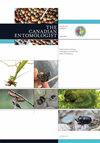Larval Phenologies and Parasitoids of Two Seed-Feeding Weevils Associated with Hoary Cress and Shepherd's Purse (Brassicaceae) in Europe
IF 1.1
4区 农林科学
Q3 ENTOMOLOGY
引用次数: 6
Abstract
Abstract In Europe, Ceutorhynchus turbatus Schultze and Ceutorhynchus typhae (Herbst) (Coleoptera: Curculionidae) feed on seeds from hoary cress and shepherd's purse (Cardaria draba (L.) Desv. and Capsella bursa-pastoris (L.) Medik.); both plants are invasive in North America. In North America, C. turbatus is a candidate for biological control of hoary cress, C. typhae is adventive, and both are sympatric with cabbage seedpod weevil (Ceutorhynchus obstrictus (Marsham)), an invasive alien pest of canola (Brassica napus L. and Brassica rapa L., Brassicaceae). We investigated host associations among C. turbatus, C. typhae, and their parasitoids in Europe. Of particular interest was host specificity of Trichomalus perfectus (Walker) and Mesopolobus morys (Walker) (Hymenoptera: Pteromalidae), candidates for biological control of C. obstrictus in North America. We found no evidence that T. perfectus attacks C. turbatus or C. typhae; however, M. morys was the most common parasitoid associated with C. turbatus.欧洲两种食籽象鼻虫(芸苔科)的幼虫物候特征和寄生物
在欧洲,Ceutorhynchus turbatus Schultze和Ceutorhynchus typhae (Herbst)(鞘翅目:curculionae科)以白衣和荠菜(Cardaria draba (L.))的种子为食。Desv。和荠菜(L.)Medik);这两种植物在北美都是入侵植物。在北美,C. turbatus是白衣甘蓝生物防治的候选物种,C. typhae是外来物种,两者都与菜籽象鼻虫(Ceutorhynchus obstrictus (Marsham))同域,后者是油菜(芸苔科)的外来入侵害虫。我们调查了在欧洲的C. turbatus, C. typhae和它们的拟寄生物之间的宿主关系。特别令人感兴趣的是完美毛蝇(Trichomalus perfectus, Walker)和莫里Mesopolobus morys (Walker)(膜翅目:羽蛾科)的寄主特异性,这两种昆虫是北美硬纹夜蛾生物防治的候选者。我们没有发现完美T.攻击C. turbatus或C. typhae的证据;而与大菱鲆伴生的寄生蜂中,最常见的寄生蜂是大菱鲆。
本文章由计算机程序翻译,如有差异,请以英文原文为准。
求助全文
约1分钟内获得全文
求助全文
来源期刊

Canadian Entomologist
生物-昆虫学
CiteScore
2.20
自引率
11.10%
发文量
24
审稿时长
6-12 weeks
期刊介绍:
French translation follows/le français suit Published since 1868, this peer-reviewed bimonthly publication is the official journal of the Entomological Society of Canada. Available via the internet and with hardcopy distribution to 55 countries, its research papers and notes are relevant to entomologists and other biologists around the world. In addition to being a venue for topical reviews and forum discussion, The Canadian Entomologist publishes current research in all facets of entomology, including systematics and morphology, molecular and developmental biology, ecology and behaviour, biodiversity and evolution, insect management, entomological techniques, and other relevant subject areas. Contributions are published in English or French. Authors will not pay page charges, and will experience fast, high quality reviews of their papers.Publiée depuis 1868, cette publication bimestrielle avec comité de lecture est la revue officielle de la Société d’entomologie du Canada. Disponible sur Internet et distribuée en format papier dans 55 pays, ses articles de recherche et ses notes sont pertinents pour les entomologistes et autres biologistes de par le monde. En plus d’être une plate-forme pour des revues thématiques et un forum de discussion, The Canadian Entomologist publie la recherche actuelle sur toutes les facettes de l’entomologie, incluant la systématique et la morphologie, la biologie moléculaire et développementale, l’écologie et le comportement, la biodiversité et l’évolution, la gestion des insectes, les techniques entomologiques et d’autres domaines pertinents. Les contributions sont publiées en français ou en anglais. Les auteurs ne paient aucun frais de publication, et recevront une révision rapide et de grande qualité de leurs articles.
 求助内容:
求助内容: 应助结果提醒方式:
应助结果提醒方式:


